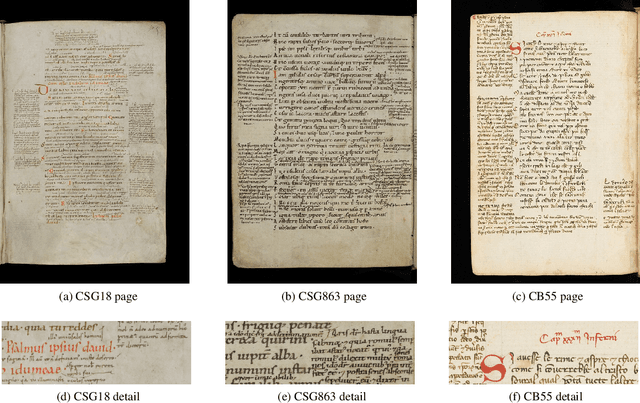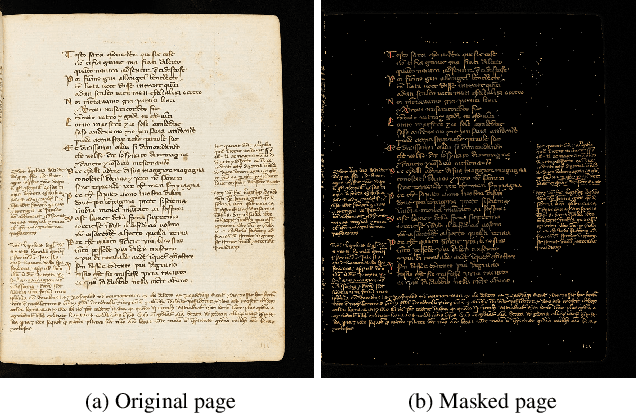Axel De Nardin
ICDAR 2025 Competition on FEw-Shot Text line segmentation of ancient handwritten documents (FEST)
Sep 16, 2025Abstract:Text line segmentation is a critical step in handwritten document image analysis. Segmenting text lines in historical handwritten documents, however, presents unique challenges due to irregular handwriting, faded ink, and complex layouts with overlapping lines and non-linear text flow. Furthermore, the scarcity of large annotated datasets renders fully supervised learning approaches impractical for such materials. To address these challenges, we introduce the Few-Shot Text Line Segmentation of Ancient Handwritten Documents (FEST) Competition. Participants are tasked with developing systems capable of segmenting text lines in U-DIADS-TL dataset, using only three annotated images per manuscript for training. The competition dataset features a diverse collection of ancient manuscripts exhibiting a wide range of layouts, degradation levels, and non-standard formatting, closely reflecting real-world conditions. By emphasizing few-shot learning, FEST competition aims to promote the development of robust and adaptable methods that can be employed by humanities scholars with minimal manual annotation effort, thus fostering broader adoption of automated document analysis tools in historical research.
* Accepted to ICDAR 2025
U-DIADS-Bib: a full and few-shot pixel-precise dataset for document layout analysis of ancient manuscripts
Jan 16, 2024Abstract:Document Layout Analysis, which is the task of identifying different semantic regions inside of a document page, is a subject of great interest for both computer scientists and humanities scholars as it represents a fundamental step towards further analysis tasks for the former and a powerful tool to improve and facilitate the study of the documents for the latter. However, many of the works currently present in the literature, especially when it comes to the available datasets, fail to meet the needs of both worlds and, in particular, tend to lean towards the needs and common practices of the computer science side, leading to resources that are not representative of the humanities real needs. For this reason, the present paper introduces U-DIADS-Bib, a novel, pixel-precise, non-overlapping and noiseless document layout analysis dataset developed in close collaboration between specialists in the fields of computer vision and humanities. Furthermore, we propose a novel, computer-aided, segmentation pipeline in order to alleviate the burden represented by the time-consuming process of manual annotation, necessary for the generation of the ground truth segmentation maps. Finally, we present a standardized few-shot version of the dataset (U-DIADS-BibFS), with the aim of encouraging the development of models and solutions able to address this task with as few samples as possible, which would allow for more effective use in a real-world scenario, where collecting a large number of segmentations is not always feasible.
Efficient few-shot learning for pixel-precise handwritten document layout analysis
Oct 27, 2022



Abstract:Layout analysis is a task of uttermost importance in ancient handwritten document analysis and represents a fundamental step toward the simplification of subsequent tasks such as optical character recognition and automatic transcription. However, many of the approaches adopted to solve this problem rely on a fully supervised learning paradigm. While these systems achieve very good performance on this task, the drawback is that pixel-precise text labeling of the entire training set is a very time-consuming process, which makes this type of information rarely available in a real-world scenario. In the present paper, we address this problem by proposing an efficient few-shot learning framework that achieves performances comparable to current state-of-the-art fully supervised methods on the publicly available DIVA-HisDB dataset.
Masked Transformer for image Anomaly Localization
Oct 27, 2022Abstract:Image anomaly detection consists in detecting images or image portions that are visually different from the majority of the samples in a dataset. The task is of practical importance for various real-life applications like biomedical image analysis, visual inspection in industrial production, banking, traffic management, etc. Most of the current deep learning approaches rely on image reconstruction: the input image is projected in some latent space and then reconstructed, assuming that the network (mostly trained on normal data) will not be able to reconstruct the anomalous portions. However, this assumption does not always hold. We thus propose a new model based on the Vision Transformer architecture with patch masking: the input image is split in several patches, and each patch is reconstructed only from the surrounding data, thus ignoring the potentially anomalous information contained in the patch itself. We then show that multi-resolution patches and their collective embeddings provide a large improvement in the model's performance compared to the exclusive use of the traditional square patches. The proposed model has been tested on popular anomaly detection datasets such as MVTec and head CT and achieved good results when compared to other state-of-the-art approaches.
 Add to Chrome
Add to Chrome Add to Firefox
Add to Firefox Add to Edge
Add to Edge